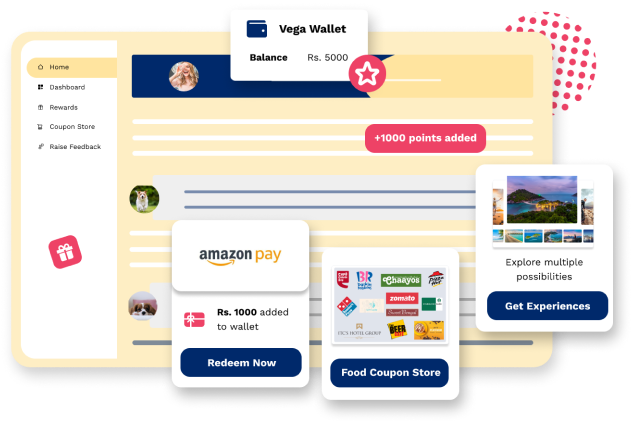Engaged Employees are the Heartbeat of a Thriving Organization
In the year 2022, we witnessed a whirlwind of workplace trends that had a profound impact. Early on, a significant number of individuals embarked on the 'Great Resignation' journey, leading to talent shortages across various industries. We also saw a paradigm shift in employee expectations from their organizations. Employees now seek fair wages, comprehensive benefits, and increased flexibility, demanding more from their employers.
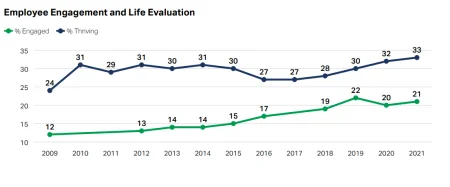
Source: EmpMonitor
As we step into 2023, concerns about talent shortages persist, with executives apprehensive about how economic uncertainty will affect their workforce and overall profitability. Remote work, which gained prominence during the pandemic, appears to have become a permanent thing. While around 44% of CEOs express a desire to bring employees back to the office, they hesitate to enforce it due to the tight labor market. Their concerns are well-founded, as a recent study revealed that over 60% of respondents would actively seek new job opportunities if remote work was no longer an option. Over the past couple of years, the landscape of effective employee engagement has undergone a significant transformation, with workplaces swiftly adapting to these challenges.
Given the shifting priorities of employees in the current scenario, building and enhancing employee engagement strategies has become more challenging than ever. In this article, we explore six of the latest trends in employee engagement, equipping you with the knowledge to craft the most effective engagement strategy for your organization.
Employee Engagement Trends for 2023
Trend #1 - People-First Culture
In a thriving people-first work culture, every employee's voice is not only heard but truly valued. We go beyond superficial gestures by conducting regular check-ins and empowering employees through opinion surveys. These powerful tools allow us to gather authentic feedback and measure the true pulse of employee engagement. Armed with these invaluable insights, we ignite a transformative journey to reshape our culture and elevate the employee experience to unprecedented heights.
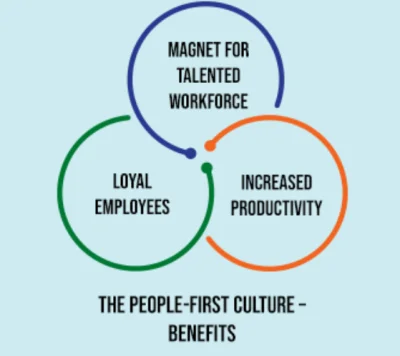
Source: Etech
It is crucial not only to collect feedback but also to take action based on it. Surveys may uncover minor issues that can be swiftly addressed for immediate positive impact. On the other hand, larger concerns may require a more comprehensive approach. By sharing your plan for addressing these issues with your employees and keeping them informed about the progress of implementation, you demonstrate a genuine commitment to meaningful change and ensure that their voices continue to be heard.
Recognizing employees is another vital aspect of fostering a people-first culture. A recent study revealed that employees who perceive their managers as skilled in recognizing their efforts are 40% more engaged than their peers. To effectively reward and recognize employees, tailor your programs to align with their working setups, priorities, and available resources. For instance, an employee-of-the-month bulletin board may not be suitable if your team doesn't have a shared physical workspace. Instead, consider a company-wide virtual chat or platform that includes everyone. Social recognition serves as a powerful motivator, inspiring employees to perform at their best and uplifting overall team morale.
Trend #2 - Flexibility and Work-Life Balance
The concept of flexible and remote working has gained significant momentum in recent years and is now firmly established as a lasting trend. This approach has become a paramount concern due to its ability to enhance the work-life balance of employees.
Amidst the COVID-19 lockdowns, employees worldwide were compelled to transition to remote work for an extended duration. This unforeseen circumstance afforded them additional time to allocate towards personal endeavors, such as cherishing moments with their families, prioritizing their health, and engaging in hobbies to foster improved mental well-being.
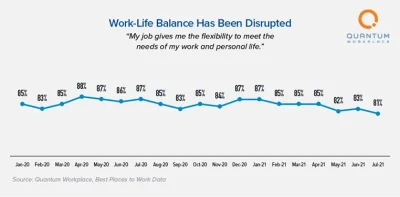
Source: Quantum
Not only does flexible working contribute to an enhanced work-life balance, but according to a Gartner survey, it also resulted in increased productivity for 43% of the respondents. Flexible working extends beyond remote work scenarios and encompasses employees who are required to be physically present for their jobs. This approach includes various options, such as enabling workers to select their preferred work locations, providing flexibility in shift schedules, or granting compensatory time off when they exceed their contracted hours.
With greater control over their time, employees experience higher levels of happiness, energy, and overall performance, leading to greater loyalty to their company.
Trend #3 - The Rising Tide of AI and ML
Over the past few years, there has been a notable rise in the adoption of advanced and efficient HR tools for effective people management. This trend is poised to continue its upward trajectory due to the widespread integration of machine learning (ML) and artificial intelligence (AI) in the workplace.
Forward-thinking organizations have already embraced AI and ML in multiple areas of their operations, yielding substantial returns on their investments. These technologies have proven successful so far.
AI is revolutionizing communication channels and enabling personalized actions within the workplace. HR departments can now make more informed, data-driven, and logical decisions. Moreover, the availability of data is assisting managers in comprehending the factors that drive employee productivity.
Trend #4 - Diversity, Equity, and Inclusion (DEI)
Over the past years, there has been a growing emphasis on equity, diversity, and inclusion, both within and beyond the workplace. The new generation of employees places significant importance on diversity, equity, and inclusion (DEI) and strives to distance themselves from any form of discrimination based on race, gender, disability, sexual orientation, or other relevant factors.
Employers are expected to embrace positive practices starting from the hiring process, where candidates should be evaluated solely on their merit. Additionally, employees desire fair opportunities for promotion and compensation, necessitating a mindful and transparent approach.
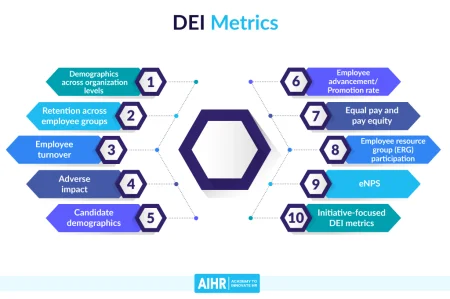
Providing unconscious bias training across all levels of the organization is also beneficial. This allows employees to actively contribute to creating and sustaining an inclusive work environment. Establishing employee resource groups that organize and execute diversity events can effectively foster a sense of inclusion within the company. Furthermore, demonstrating a commitment to disability-friendly work sites and respecting holidays from diverse cultures contributes to employees feeling valued and secure.
Ideally, in 2023, diversity, equity, and inclusion will become integral components of comprehensive employee engagement strategies.
Trend #5 - The Reign of Cloud Technology Persists
Cloud-based tools are set to continue making significant strides in the field of human resource management. According to a 2018 study by PwC, 75 percent of surveyed companies have already adopted at least one cloud-based HR process.
Technology has already permeated every aspect of HR management, from employee benefits platforms and performance management tools to employee recognition and survey tools. This integration has streamlined processes and enabled organizations to achieve better and faster results.
These tools offer a mutually beneficial proposition for both employers and employees. The current generation, characterized as digital nomads, thrives in remote work environments, and leveraging HR technology is the most effective way to engage them.
Cloud products have already gained popularity due to their efficiency and user-friendly nature. As more companies recognize the advantages, a mass migration into this space is expected. Consequently, investing in the right engagement tool, such as Vega HR, will become crucial for companies in 2023.
Trend #6 - Fostering a Company Culture of Community and Connection
When it comes to measuring employee engagement, there's nothing quite as effective as teamwork. The strength of collaboration and coordination among team members directly impacts the level of engagement they experience. In fact, a study conducted by the ADP Research Institute reveals that employees who work as part of a team are 2.3 times more likely to be fully engaged. This highlights the significant impact of teamwork on the best employee engagement levels.
This stems from our innate social nature as humans, desiring to navigate life collectively. We seek to uplift and support each other, fostering a sense of belonging and readily seeking assistance from our community whenever needed.
Regrettably, following the peak of the COVID pandemic, employees observed a decline in communication from their leaders. Whether it pertained to safety protocols or organizational adjustments, there was a noticeable decrease in transparency from management, resulting in a decline in employee engagement.
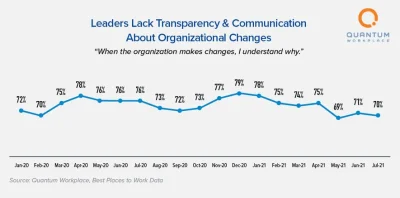
Source: Quantum
That's why it's crucial to ensure that employees never feel neglected or left out. One effective approach is conducting employee surveys to gather their feedback and understand how you can offer support. Additionally, investing in inclusive communication tools and software is vital, catering to the needs of all employees, whether they work in-office, remotely, or in a hybrid setup. By prioritizing these measures, you can foster a sense of inclusion and engagement among your workforce.
Final Thoughts
Ensuring robust employee engagement strategies is a significant concern for effective human resource management, and rightfully so. Disengaged employees not only exhibit reduced productivity and increased likelihood of attrition but can also harm your reputation among customers and potential talent. However, with shifting employee priorities, engagement tactics that were effective in the past may not hold the same power today. In this article, we explore the latest trends in employee engagement, providing you with valuable insights to craft an impactful plan for your company.
While understanding the overall employee engagement trends of 2023 is crucial, it is equally important to comprehend what motivates and inspires your own workforce. Conducting employee surveys, maintaining regular communication, offering relevant benefits, and leveraging AI and ML technologies are excellent methods to achieve this customization.
By adopting these insights, you will remain ahead of the curve, retain your valuable employees, and gain a competitive advantage in the ongoing battle for talent.
Frequently asked questions
About Vega HR
Vega-HR is a powerful tool in the talent war, offering employee rewards, recognition, and pulse recognition. With an engaging platform, it fosters a world-class work culture, providing P2P recognition, social feedback, on-spot recognition, and monetizable incentive solutions with 3000+ coupons in various categories.
Create a Culture People Want to Stick to
- Send rewards
- Give shoutouts
- Build a community
- Gift experiences
Get a demo
 Written by Ali Kidwai 19 May 2023 | 4 min read
Written by Ali Kidwai 19 May 2023 | 4 min read





